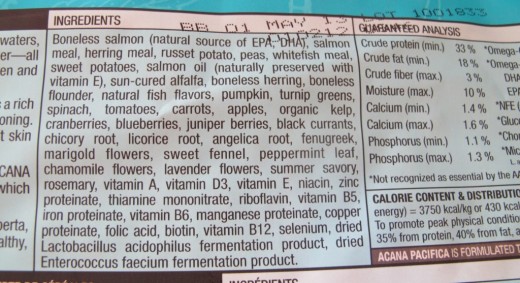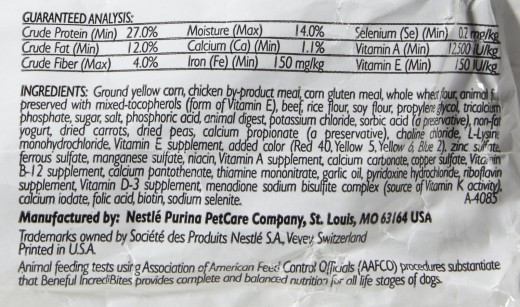The food we consume is regulated by nutritional experts and closely monitored for quality, but knowing what goes in to our dogs food should not be such a mystery. A general rule of thumb I have adopted into my own lifestyle, is if I cannot pronounce it I am not eating it and I have applied this to my animal’s health too. Dog food labels can be confusing and misleading, what may look like a “wholesome” or “natural” dog food is really just full of chemicals and fillers. Bellow I have compared two dog food labels, the first one; Acana which is good baseline dog food. And beneful, a grocery brand dog food. Notice how the ingredient list in Acana is full of things we recognize and can pronounce. Where as in Beneful, it contains weird chemicals, and chicken by-product meal.
 Acana
Acana
 Beneful
Beneful
Listed Ingredients
Pet Food companies are required by law to list all the ingredients by order of predominance and also to list vitamins and minerals by their chemical name. This can result in multiple different ingredients you have never seen or heard of before. For example, ferrous sulfate might sound harmful, when really it is just a source of iron. However there are definitely ingredients that you should avoid in your pet food, such as, Propylene Glycol. Which is a preservative to help semi-moist food stay hydrated, however if consumed on a daily bases it is toxic.
One important thing to note is the first two ingredients listed. Normally it is a meat by product or whole meat then another source of protein, such as peas or potatoes. The crude protein listed in the guaranteed analysis might be 27%, however it is not straight meat protein. Because a fiber source is the second item on the list. It highly likely that the majority of the crude protein is coming from pea protein versus meat. If you take a look at the two ingredient lists above, Acana and Beneful shows this exactly. Acana’s first few ingredients are a meat source. So we know that the majority of the protein is coming from meat. Where a Beneful has ground corn-meal, chicken by product meal, then corn again.
Guaranteed Analysis
This is where we learn what the percent values in your dogs food are. Depending on your dogs age, and health this will dictate what you are looking. The Association of American Feed Control Officials (AAFCO) has set out recommended minimums and sometimes maximum levels of nutrients. An very important factor to remember when comparing two different labels is that not all dog food kibbles have the same moisture levels. Meaning if you are trying to compare the two different foods you have to make everything equal. So we use a simple formula to find the actual true percentages of fat and protein in the kibble.
So lets use Benful as the example.
100% Dry matter – 14% Moisture = 86% Actual Dry Matter
27% Protein / 86% Actual Dry Matter = 31% True Protein
12% Fat / 86% Actual Dry Matter = 13% True Fat
Then Acana.
100% Dry Matter – 10% Moisture = 90% Actual Dry Matter
33% Protein / 90% Actual Dry Matter = 36% True Protein
18% Fat / 90% Actual Dry Matter = 20% True Fat
The nutritional Adequacy Statement is one of the more important statements too when looking at the labels it can impact your pet’s health if claims are made that it is nutritionally complete when the prodcut is not able to meet any of the requirements set out by the AAFCO. Think of the AACFO as the FDA for pet food. Look for statements like,
“…. is formulated to meet the nutritional levels established by the AAFCO (Dog/Cat) Food Nutrient Profiles.”
or
“Animal feeding tests using AAFCO procedures substantiate that …. provides complete and balanced nutrition.”
Feeding Directions
At minimum, some where on the label should include wording such as “feed ___ cups per ___ pounds of body weight daily.” The feeding directions should be taken as rough guidelines, a place to start. Breed, temperament, environment, and many other factors can influence food intake. Dog food brands attempt to cover almost all scenarios by setting the directions for the most demanding of situation. The best suggestion is to offer the recommended amount at first, and then to increase or cut back as needed to maintain body weight in adults.
Understanding the requirements of a pet food label helps to ensure that your dog’s nutritional needs are being met. The best advice I can give you is to monitor your dogs activity levels, and adjust the amount of food at feeding time. Or switch the food to something that offers higher or lower fat content depending on the situation. Our pets rely on us to provide them the best care and nutrition we can offer. Understanding the basics to dog food labels is just a small thing we can do in being a better pet parent.
Rebecca 




 I often buy my clan homemade treats from a dog bakery or
I often buy my clan homemade treats from a dog bakery or 

 Acana
Acana